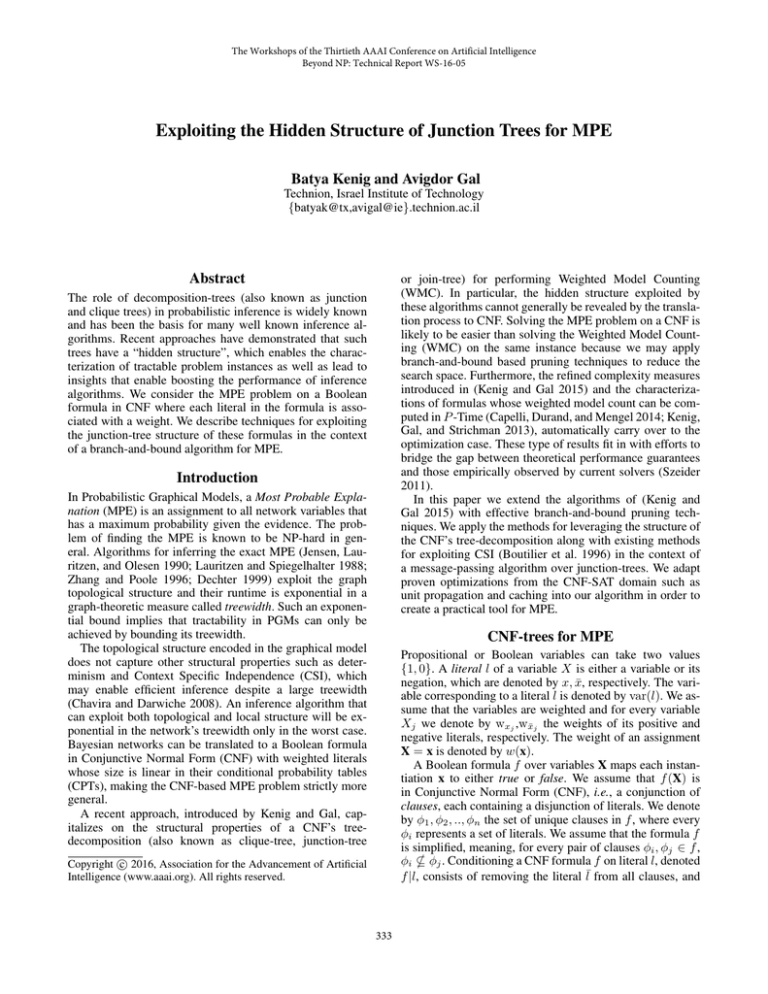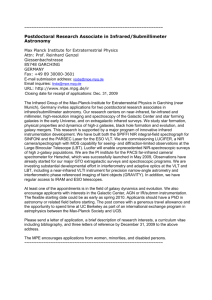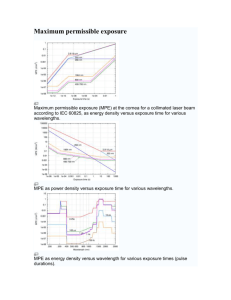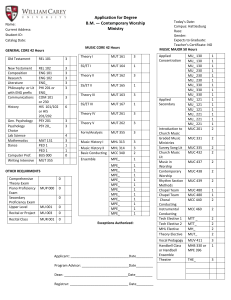
The Workshops of the Thirtieth AAAI Conference on Artificial Intelligence
Beyond NP: Technical Report WS-16-05
Exploiting the Hidden Structure of Junction Trees for MPE
Batya Kenig and Avigdor Gal
Technion, Israel Institute of Technology
{batyak@tx,avigal@ie}.technion.ac.il
Abstract
or join-tree) for performing Weighted Model Counting
(WMC). In particular, the hidden structure exploited by
these algorithms cannot generally be revealed by the translation process to CNF. Solving the MPE problem on a CNF is
likely to be easier than solving the Weighted Model Counting (WMC) on the same instance because we may apply
branch-and-bound based pruning techniques to reduce the
search space. Furthermore, the refined complexity measures
introduced in (Kenig and Gal 2015) and the characterizations of formulas whose weighted model count can be computed in P -Time (Capelli, Durand, and Mengel 2014; Kenig,
Gal, and Strichman 2013), automatically carry over to the
optimization case. These type of results fit in with efforts to
bridge the gap between theoretical performance guarantees
and those empirically observed by current solvers (Szeider
2011).
In this paper we extend the algorithms of (Kenig and
Gal 2015) with effective branch-and-bound pruning techniques. We apply the methods for leveraging the structure of
the CNF’s tree-decomposition along with existing methods
for exploiting CSI (Boutilier et al. 1996) in the context of
a message-passing algorithm over junction-trees. We adapt
proven optimizations from the CNF-SAT domain such as
unit propagation and caching into our algorithm in order to
create a practical tool for MPE.
The role of decomposition-trees (also known as junction
and clique trees) in probabilistic inference is widely known
and has been the basis for many well known inference algorithms. Recent approaches have demonstrated that such
trees have a “hidden structure”, which enables the characterization of tractable problem instances as well as lead to
insights that enable boosting the performance of inference
algorithms. We consider the MPE problem on a Boolean
formula in CNF where each literal in the formula is associated with a weight. We describe techniques for exploiting
the junction-tree structure of these formulas in the context
of a branch-and-bound algorithm for MPE.
Introduction
In Probabilistic Graphical Models, a Most Probable Explanation (MPE) is an assignment to all network variables that
has a maximum probability given the evidence. The problem of finding the MPE is known to be NP-hard in general. Algorithms for inferring the exact MPE (Jensen, Lauritzen, and Olesen 1990; Lauritzen and Spiegelhalter 1988;
Zhang and Poole 1996; Dechter 1999) exploit the graph
topological structure and their runtime is exponential in a
graph-theoretic measure called treewidth. Such an exponential bound implies that tractability in PGMs can only be
achieved by bounding its treewidth.
The topological structure encoded in the graphical model
does not capture other structural properties such as determinism and Context Specific Independence (CSI), which
may enable efficient inference despite a large treewidth
(Chavira and Darwiche 2008). An inference algorithm that
can exploit both topological and local structure will be exponential in the network’s treewidth only in the worst case.
Bayesian networks can be translated to a Boolean formula
in Conjunctive Normal Form (CNF) with weighted literals
whose size is linear in their conditional probability tables
(CPTs), making the CNF-based MPE problem strictly more
general.
A recent approach, introduced by Kenig and Gal, capitalizes on the structural properties of a CNF’s treedecomposition (also known as clique-tree, junction-tree
CNF-trees for MPE
Propositional or Boolean variables can take two values
{1, 0}. A literal l of a variable X is either a variable or its
negation, which are denoted by x, x̄, respectively. The variable corresponding to a literal l is denoted by var(l). We assume that the variables are weighted and for every variable
Xj we denote by wxj ,wx̄j the weights of its positive and
negative literals, respectively. The weight of an assignment
X = x is denoted by w(x).
A Boolean formula f over variables X maps each instantiation x to either true or false. We assume that f (X) is
in Conjunctive Normal Form (CNF), i.e., a conjunction of
clauses, each containing a disjunction of literals. We denote
by φ1 , φ2 , .., φn the set of unique clauses in f , where every
φi represents a set of literals. We assume that the formula f
is simplified, meaning, for every pair of clauses φi , φj ∈ f ,
φi * φj . Conditioning a CNF formula f on literal l, denoted
f |l, consists of removing the literal ¯l from all clauses, and
c 2016, Association for the Advancement of Artificial
Copyright Intelligence (www.aaai.org). All rights reserved.
333
dropping the clauses that contain l. Conditioning a formula
on a set of literals γ = {l1 , l2 , ..., lk }, denoted f |γ, amounts
to conditioning it on every literal l ∈ γ.
We say that a variable X affects the formula’s outcome if
f |x 6= f |x̄. We denote by var(f ) the set of variables that
affect the formula. A pair of formulae f1 , f2 are disjoint if
var(f1 ) ∩ var(f2 ) = ∅. The model of f with the maximum
weight (or probability) is denoted MPE(f ).
We model the formula f (X) as a CNF interaction graph,
an undirected graphical model, Gf (X, E), where each variable corresponds to a node in the graph and there is an edge
between pairs of variables that belong to a common clause.
Let Tr (I) denote a rooted junction tree for Gf (X, E),
where I represents the node indices, and the members of
each node i ∈ I are denoted Xi . According to the junction tree properties, each clause, φi ∈ f , is associated with
a node i ∈ I such that var(φi ) ⊆ Xi . This node-clause
relationship is reflected in the tree by attaching a leaf, representing the clause, to its associated tree-node. For example,
consider the CNF formula and its junction tree in Fig. 1. The
shaded leaf nodes represent clauses.
The leaf-node factors corresponding to the CNF clauses
have two roles. They materialize the evidence dictating that
the corresponding clause is satisfied (any MPE assignment
satisfies the formula). Second, they return a satisfying assignment to its variables with the maximum weight. We provide the factor’s formal definition in the following section.
Given an encoding of the PGM into a Boolean formula in
CNF, the MPE assignment and probability can be read off
from the model with the maximum weight.
Let Tr (I) be a CNF-tree rooted at node r. For each treenode index i ∈ I, we denote by Fi (Xi ) the factor associated
with this node, Ti the subtree rooted at node i, and by fi
the subformula induced by the clauses in this subtree. For
example, the formulae represented by subtrees T1 , T2 rooted
at nodes 1, 2 respectively in Fig. 1 are f1 = φ1 φ4 φ6 and
f2 = φ2 φ5 φ7 . The children of tree-node i are denoted chi .
In the general setting, a separator set Si,j = Xi ∩ Xj ,
between junction tree nodes i, j, enables inducing independence between variables on different sides of the edge only
when all of the variables in Si,j have been assigned a value
(Darwiche 2009). We observe, however, that in CNF-trees
this requirement may be too strict. Considering the CNF
and corresponding CNF-tree in Figure 1, the partial assignment γ = {x1 } renders the reduced formulas f1 |γ = φ6 ,
f2 |γ = φ5 φ7 and f3 |γ = ∅ disjoint even though variables
X2 and X4 remained unassigned.
Discovering partial, rather than complete assignments,
which decompose the formula will reduce factor sizes and
enable more efficient inference. Therefore, a central notion
in message-passing algorithms over CNF-trees is that of a
valid assignment defined below.
Figure 1: A CNF-tree for the formula f =
(a) F0
V7
i=1
φi .
(b) F00
Figure 2: Two possible tree-CPTs for root-node i = 0 (X0 =
{X1 , X2 , X4 , X5 }) of the CNF-tree in Fig. 1.
2. fi |y is decomposed to pairwise-disjoint sub-formulas
f1 |y, f2 |y, ..., fm |y.
The factors of internal CNF-tree nodes are represented by
tree-CPTs (Boutilier et al. 1996) where non-terminal vertices represent variables and terminal vertices correspond to
the assignment defined by the path from the root.
Example 1. An example of two possible tree-CPTs for the
root-node i = 0 in the CNF-tree of Fig. 1 appear in Fig. 2.
Note the terminal vertex in Fig. 2a that represents assignment γ2 = {x̄2 , x1 }. The partial assignment γ2 induces subformulas f1 |γ2 = x4 ∨ x8 , f2 |γ2 = φ5 φ7 and f3 |γ2 = ∅,
which correspond to subtrees T1 , T2 , T3 , respectively. Given
assignment γ2 , these subformulas are consistent and pairwise disjoint, e.g., var(f1 |γ2 ) ∩ var(f2 |γ2 ) = ∅, thus the
partial assignment γ2 is valid.
From a performance point of view, our goal is to generate the smallest factor for each CNF-tree node. Namely, per
each node, we would like to identify the smallest set of mutual exclusive and exhaustive valid partial assignments. The
work in (Kenig and Gal 2015) provides techniques for reducing the size of tree-CPTs according to the CNF-tree topology
and identifies a family of formulas with a linear-sized treeCPTs whose MPE (and WMC) can be computed in P -time.
Definition 1. Let Tr (I) be a CNF-tree rooted at node r and
i ∈ I a node in Tr with chi = {i1 , i2 , ..., im }. Let Y = y
be a partial assignment to Xi . y is called a valid (partial) assignment to Xi if the following two conditions are satisfied:
1. Y = y is consistent (fi |y 6= 0)
334
The runtime complexity of a message passing algorithm
operating over a CNF-tree is exponential in a measure
termed CNF-tw. Intuitively, this measure reflects the number of distinct CNFs resulting from the different valid assignments associated with a tree-CPT factor.
Algorithm
1:
MPE CNF T(Tr , e),
hPrM P E (fr , e), MPE(fr , e)i
1:
2:
3:
4:
5:
6:
7:
8:
9:
10:
11:
12:
Basic MPE procedure with CNF-trees
The MPE assignment and weight for a Boolean formula in
CNF are formally defined next.
Definition 2. Let f (X) denote a Boolean formula in CNF, e
denote evidence, and Q = X \ var(e) the set of unassigned
variables. The MPE probability, given evidence e, is defined
as:
PrM P E (f, e) = max w(q)
13:
14:
15:
16:
17:
18:
19:
q:f |eq=1
The set of MPE assignments that attain this maximal weight
are defined as:
MPE(f, e) = arg max w(q)
q:f |eq=1
The leaf-factors (Def. 3), representing clauses, return the
partial assignment with the maximal weight, satisfying the
clause.
Definition 3. Let i denote an incidence of a leaf node in a
CNF-tree, representing the clause φi , and let E = e denote
some evidence. Let Ui = var(φi ) \ E denote the unassigned
variables in φi , u∗i = arg maxui w(ui ) an assignment that
∗
maximizes the weights to its members,
and w(ui ) its weight.
wl
Finally, let v = arg maxl∈φi |e
denote the literal with
ŵl
the largest positive to negative assignment ratio, and u∗∗
i
the assignment in which literal v is set, and the rest of the
literals are assigned as in u∗i . Then Fφi : e → hR, ui i is:
h0, ∅i
if φi |e = 0
∗
∗
∗
hw(u
),
u
i
i
if φi |eui = 1
(1)
Fφi (e) = i
w
w(u∗i ) · v , u∗∗
otherwise
ŵv i
20:
21:
22:
23:
24:
25:
26:
27:
28:
29:
returns
if r is a leaf-node then
return Fr (e) {By eq. 1}
end if
if cache(var(e), fr |e) 6= nil then
hPrM P E (fr , e), MPE(fr , e)i ← cache(var(e), fr |e)
return hPrM P E (fr , e), MPE(fr , e)i
end if
Ver ← var(fr |e) {reduced formula vars}
MPE(fr , e) ← 0.0 {init the return value}
while γ ← nextValid(γ, fr |e, Xr \ var(e)) 6= nil do
Veγ
r ← var(fr |eγ) {reduced formula vars}
β ← ∅ {The maximizing assignment to
subsumed vars }
for X ∈ Ver \ Veγ
r do
β ← β ∪ arg max{x,x̄} (wx , ŵx )
end for
γ ← γβ {Update the valid assignment}
Pr(γ) ← w(γ) {Init assignment prob by its weight}
for node n ∈ chr do
hPrM P E (fn , eγ), MPE(fn , eγ)i ←
MPE CNF T(Tn , eγ) {recurse}
Pr(γ) ← Pr(γ) × PrM P E (fn , eγ)
γ ← γMPE(fn , eγ) {update assignment according
to the result from child}
end for
if Pr(γ) > PrM P E (fr , e) then
PrM P E (fr , e) ← Pr(γ)
MPE(fr , e) ← γ
end if
end while
cache(var(e), fr |e) ← hPrM P E (fr , e), MPE(fr , e)i
return hPrM P E (fr , e), MPE(fr , e)i
and returns the MPE assignment and probability (Def. 2). If
r is a leaf node, then the appropriate assignment and probability are returned in line 2 according to the leaf factor (Def.
3). If the cache contains the result for fr |e, it is returned in
line 5. In line 8, the set of affecting variables, those that appear in at least one unsubsumed clause in fr |e, is placed in
Ver .
Valid assignments are processed in lines 10-27. Generating the set of valid assignments is described in (Kenig
and Gal 2015). Each valid assignment, γ, induces the reduced subformula fr |eγ. Since the newly subsumed variables (Ver \ Veγ
r ) do not affect the formula, they can be assigned the value maximizing their weight (lines 13-15).
The children of r are processed in lines 18-22. The algorithm is recursively called on each of r’s subtrees, Tn , in
line 19. After its return, the MPE probability and assignment, given evidence eγ, are updated in lines 20 and 21,
respectively. By definition of valid assignments (Def. 1), the
subformulas corresponding to r’s children are disjoint, enabling the update.
MPE(fr , e), the model of fr |e with the highest probability, is set in lines 23-26. Since the valid assignments are mutual exclusive and exhaustive, the maximization operator, effectively applied in lines 23-26, returns the expected value.
Example 2. Consider clause φi = (x1 , x̄2 , x3 ). Assume without loss of generality that ŵx > wx for x ∈
{x1 , x2 , x3 }. Let us calculate Fφi (e) for e1 = x̄2 and
e2 = x2 . Since φi |e1 is satisfied then the factor will assign
x1 and x3 with values that maximize their joint weight, i.e.,
u∗i = {x̄1 , x̄3 }, and the weight returned is w(u∗i ).
This is not the case for e2 = x2 , which does not satisfy the
clause. Moreover, the assignment to the unassigned literals
that maximizes their joint weight, u∗i = {x̄1 , x̄3 }, does not
satisfy the clause either. Therefore, we flip the value of the
literal that will lead to the smallest decrease in the maximal
l
weight. Assuming (w.l.o.g) that x1 = arg maxl∈φi |e2 w
ŵl ,
∗∗
then the resulting assignment returned by the factor is ui =
{x1 , x̄3 }.
It is worth noting that maximizing the partial assignment,
returned by a leaf factor, can be computed in time that is
linear in the number of variables in the clause.
Algorithm 1 presents the basic procedure for computing
the MPE. It receives a rooted CNF-tree Tr , and evidence e,
335
Y ∈ X and X1 ∩ X2 = ∅. Furthermore, assume that wy =
ŵȳ = 0.5, then
Finally, the result is cached and returned in lines 28 and 29,
respectively.
PrM P E (f (X)) = max Pr(f (x))
x
= max max Pr(f1 (x1 , y)) · max Pr(f2 (x2 , y))
Bounding and pruning
We can improve the performance of algorithm MPE CNF T
by pruning a portion of the search space, at each CNF-treenode, using an upper bound on the MPE probability. Suppose for example that the algorithm is called with CNF-treenode r, and evidence e. If we have already encountered a
complete assignment that has probability p, and we know
that every completion of instantiation e (to all variables in
fr , var(fr )) will not lead to a higher probability, we can
abandon this partial assignment as it would not lead to instantiations that improve on the one previously found.
Let PruM P E (fr , e) stand for the calculated upper bound
of the MPE probability PrM P E (fr , e) (updated in line 24).
We can modify Algorithm MPE CNF T by inserting the following line just before line 8:
y
x1
x2
= β max Pr(f1 (x1 , y1 ))
max Pr(f2 (x2 , y2 )) Eq(y1 , y2 )
x1 ,y1
x2 ,y2
≤ β max Pr(f1 (x1 , y1 ))
x1 ,y1
max Pr(f2 (x2 , y2 ))
x2 ,y2
(2)
where Eq is the equality predicate, and β = 2.
When f is an encoding of a Bayesian network to a
knowledge-base in CNF, and Y is an indicator variable (i.e.,
has a specific role in the translation to CNF and wy =
ŵȳ = 1.0, see (Chavira and Darwiche 2008)), then β = 1.0.
This is actually an instance of variable-splitting where Y is
split into two variables Y1 , Y2 (Choi, Chavira, and Darwiche
2007). Once the equality constraint is relaxed, the formula
becomes less constrained enabling the generation of a higher
probability. In other words, relaxing the formula by ignoring
certain dependency constraints between its variables results
in upper bounds that can be used to prune the search space
in the MPE CNF T algorithm. Clearly, the accuracy of the
bound deteriorates as the size of the ignored dependencies,
or split variables, increases.
We quantify the complexity of computing upper bounds
for CNF-tree nodes using the CNF-tw parameter (Kenig and
Gal 2015). That is, the computational effort put into computing these bounds should be no greater than exactly solving
a formula whose CNF-tw = k. If the length of each treeCPT branch, generated during the algorithm, were limited
to k, then, in the worst case, the tree-CPT would grow into a
full binary tree whose height is k + 1. Since the number of
leaves in such a tree is exponential in its height, i.e., 2k+1 ,
then the number of leaves, representing assignments, would
be limited to 2k+1 , restricting the complexity as required.
We refer to this restriction as a k-bound. Executing algorithm MPE CNF T with this bound causes it to generate treeCPTs whose assignments contain at most k decision variables. Since these assignments do not necessarily decompose the formula i.e., they are not valid assignments (Def.
1), they result in upper bounds to the actual probabilities.
These upper bounds are stored in a distinct cache and are
then used to prune the search space. Broadly, the procedure
is as follows.
1. Execute MPE CNF T with k-bound=k. This guarantees
that each valid assignment processed by the algorithm will
contain at most k assigned decision variables.
2. Save the cache contents as an Upper-Bound-Cache
that will hold the upper bound approximations for the corresponding formulas.
3. Generate a new, empty cache object.
4. Execute MPE CNF T with no k-bound and the new cache
object while extracting the required upper bounds from
Upper-Bound-Cache.
Determining the optimal bound, k, per instance is deferred
as part of future research.
if PruM P E (fr , e) ≤ p, return
The efficiency of the resulting algorithm will depend on
the quality of the calculated upper bounds and the time it
takes to compute them. Furthermore, our goal is to compute
the tightest bounds possible under certain time and memory
constraints.
The bound, p, can be applied in other stages of the algorithm as well. For example, assume that during the generation of the tree-CPT in procedure nextValid (line 10), a
certain tree-CPT branch induces a probability that falls below p. Obviously, any extension of this assignment to one
that is valid will induce an MPE probability below p, enabling us to prune this partial assignment, and proceed in
searching for a valid MPE assignment in a different branch
of the tree-CPT.
Now, let us assume that the weight of a valid assignment,
γ, denoted w(γ) is greater than p. In the case that during
the processing of r’s children in lines 18-22, the assignment
returned from one of the children causes the computed probability to fall below p, we can abandon the valid assignment
γ, without processing the rest of the children, thereby pruning a large portion of the search space.
All of these pruning techniques are applied recursively to
the children of the CNF-tree node by adjusting the known
MPE probability, p, according to the current evidence e,
valid assignment γ and the weights returned from the other
children.
Generating upper bounds
A technique that generates an array of upper bounds would
allow us to exchange the bound tightness with the time it
takes to compute it. Both the mini-buckets (Dechter and
Rish 1998), and the node-splitting (Choi, Chavira, and Darwiche 2007; Choi, Standley, and Darwiche 2009; Choi and
Darwiche 2010) techniques operate in this fashion. We provide an intuition of our approach using a simplified case. Let
f (X) denote a Boolean function in CNF such that
f (X) = f1 (X1 , Y ) · f2 (X2 , Y )
336
Related Work
We evaluate the proposed approach on a set of benchmark
networks from the UAI probabilistic inference challenge.
The DAOOPT solver contains a large range of settings, therefore we opted for the default configuration. We also compare
our solver with Clone (Pipatsrisawat and Darwiche 2007)
on a set of randomly generated networks. We implemented
our algorithm in C++3 and carried out the experiments on
a 2.33GHz quad-core AMD64 with 8GB of RAM running
CentOS Linux 6.6. Individual runs were limited to a 2000second time-out. In what follows, MPE CNF T refers to our
implementation of Algorithm 1 with the bounding and pruning techniques.
Current approaches for answering the MPE query compute
upper bounds by applying an exact inference algorithm on
an approximate model. Mini-buckets is an approximate inference scheme, employed in branch and bound algorithms
for computing MPE (Dechter and Rish 1998). Using this
approach, the variable elimination algorithm is applied to
the problem as long as computational resources allow it.
When this is not the case, the mini-buckets algorithm will
heuristically ignore certain dependencies, enabling the variable elimination algorithm to proceed. The mini-buckets approach can therefore be viewed as an algorithm which calculates the bound by applying an exact inference algorithm on
an approximate model, generated by removing dependencies
from the original one (Choi, Chavira, and Darwiche 2007).
A different approach, called Node-Splitting (Choi,
Chavira, and Darwiche 2007; Choi and Darwiche 2010)
computes the bounds by solving MPE queries on a relaxed,
or simplified network. The relaxation is achieved by splitting nodes of the network such that its treewidth decreases,
making it tractable to an exact inference algorithm. Since the
result on the relaxed model is no less than that of the original, the resulting figures may be used as upper bounds in a
branch and bound search algorithm for MPE.
Clone1 (Pipatsrisawat and Darwiche 2007) is a MAXSAT solver that applies node splitting, knowledge compilation, and search. There is a simple reduction between MPE
and MAX-SAT and methods for applying a MAX-SAT algorithm for solving the MPE problem have been introduced
(Park 2002). Clone applies node-splitting to bring the network to a tractable form, namely, nodes are split until the
network’s width reaches the required limit. The split network is then compiled, using the C2D compiler to a d-DNNF
circuit. Finally, the compiled circuit is used to calculate upper bounds of various partial assignments during the branch
and bound search algorithm.
In all approaches for upper-bounding the probability, including mini-buckets and node-splitting, there is a trade-off
between the tightness of the bounds of the applied heuristic,
and the efficiency of computing them. In that regard, our approach is no different. A larger k-bound results in a lower
number of variables shared between formulas solved independently, tightening the bound. A lower k-bound, on the
other hand, results in lower computational complexity. Our
approach combines this property with the ability to utilize
the junction-tree structure for speeding up the optimization
algorithm.
Grid networks The experiment results for the Grid networks are available in Table 1. These experiments were executed with a k-bound= 3. On the Grid benchmark with 50%
deterministic CPTs, DAOOPT outperformed MPE CNF T on
49 out of the 55 instances, completed by both solvers. For
the networks exhibiting a larger percentage of deterministic factors, the result is reversed. On the networks with a
75% deterministic ratio, MPE CNF T completed 82 of the
110 instances while DAOOPT managed to complete only 54
instances within the designated timeout. On the 90% deterministic ratio MPE CNF T completed 92 of the 100 instances, compared with 38 completed by DAOOPT.
Observing the relationships between the CNF-tw (Kenig
and Gal 2015) and induced-width (Marinescu and Dechter
2009) of these networks explains these results. On the instances exhibiting a large degree of local structure, the CNFtw is substantially smaller than the induced width, leading
to better performance of the MPE CNF T solver. This can be
attributed to the ability of MPE CNF T to exploit this local
structure by use of unit propagation and clause learning.
For the 50% grid networks, the CNF-tw is only slightly
lower than the induced width indicating that the additional
computational effort required for performing inference over
the CNF is not worthwhile.
Net
Grid 50
Grid 75
Grid 90
Avg./Med.
CNF-tw
19.9/20.2
18.4/18
11.7/11.8
Avg./Med.
inducedWidth
21.1/21
26.4/26.5
32.4/32
Promedas The instances of this benchmark were executed
with a k-bound of 3. Out of the 238 networks, MPE CNF T
was able to process 126 networks within the designated
timeout of 2000 seconds, while DAOOPT completed 105.
MPE CNF T outperformed DAOOPT on 68 instances, while
DAOOPT outperformed MPE CNF T on 34. The results are
plotted in Fig. 3.
We compare our solver to DAOOPT2 , an AND/OR branchand-bound solver for combinatorial optimization problems
expressed as MPE queries over PGMs (Marinescu and
Dechter 2009), and to Clone (Pipatsrisawat and Darwiche 2007), a MAX-SAT solver that applies node splitting,
knowledge compilation, and search.
2
DAOOPT
Avg./Med.
Runtime
115/4
335/52
419/84.5
Table 1: Grid networks results. Runtime values are in seconds.
Preliminary Experimental Results
1
MPE CNF T
Avg./Med.
Runtime
232/91
99/31
2/1.5
Randomly Generated Networks We tested the
MPE CNF T solver on a set of randomly generated
Available at: http://reasoning.cs.ucla.edu/clone/
Available online at: https://github.com/lotten/daoopt
3
337
Code is available at: https://github.com/batyak/PROSaiCO/
Choi, A.; Chavira, M.; and Darwiche, A. 2007. Node splitting: A scheme for generating upper bounds in bayesian networks. In UAI 2007, Proceedings of the Twenty-Third Conference on Uncertainty in Artificial Intelligence, Vancouver,
BC, Canada, July 19-22, 2007, 57–66.
Choi, A.; Standley, T.; and Darwiche, A. 2009. Approximating weighted max-sat problems by compensating for
relaxations. In Principles and Practice of Constraint Programming - CP 2009, 15th International Conference, CP
2009, Lisbon, Portugal, September 20-24, 2009, Proceedings, 211–225.
Darwiche, P. A. 2009. Modeling and Reasoning with
Bayesian Networks. New York, NY, USA: Cambridge University Press, 1st edition.
Dechter, R., and Rish, I. 1998. Mini-buckets: A general scheme for approximating inference. Journal of ACM
50:2003.
Dechter, R. 1999. Bucket elimination: A unifying framework for reasoning. Artificial Intelligence 113(1?2):41 – 85.
Jensen, F. V.; Lauritzen, S. L.; and Olesen, K. G. 1990.
Bayesian updating in causal probabilistic networks by local computations. Computational Statistics Quaterly 4:269–
282.
Kenig, B., and Gal, A. 2015. On the impact of junctiontree topology on weighted model counting. In Scalable Uncertainty Management - 9th International Conference, SUM
2015, Québec City, QC, Canada, September 16-18, 2015.
Proceedings, 83–98.
Kenig, B.; Gal, A.; and Strichman, O. 2013. A new class of
lineage expressions over probabilistic databases computable
in p-time. In SUM, 219–232.
Lauritzen, S., and Spiegelhalter, D. J. 1988. Local computations with probabilities on graphical structures and their
application to expert systems (with discussion). Journal of
the Royal Statistical Society series B 50:157–224.
Marinescu, R., and Dechter, R. 2009. AND/OR branchand-bound search for combinatorial optimization in graphical models. Artif. Intell. 173(16-17):1457–1491.
Park, J. D. 2002. Using weighted max-sat engines to solve
mpe. In Eighteenth National Conference on Artificial Intelligence, 682–687. Menlo Park, CA, USA: American Association for Artificial Intelligence.
Pipatsrisawat, K., and Darwiche, A. 2007. Clone: Solving
weighted max-sat in a reduced search space. In AI 2007: Advances in Artificial Intelligence, 20th Australian Joint Conference on Artificial Intelligence, Gold Coast, Australia, December 2-6, 2007, Proceedings, 223–233.
Szeider, S. 2011. The parameterized complexity of constraint satisfaction and reasoning. In Applications of Declarative Programming and Knowledge Management - 19th International Conference, INAP 2011, and 25th Workshop on
Logic Programming, WLP 2011, Vienna, Austria, September
28-30, 2011, Revised Selected Papers, 27–37.
Zhang, N. L., and Poole, D. 1996. Exploiting causal independence in bayesian network inference. Journal of Artificial Intelligence Research 5:301–328.
Figure 3: Promedas benchmark: Scatter plot of the runtime in
seconds for each problem instance using MPE CNF T (x-axis) and
DAOOPT (y-axis). Points above the y = x line represent problem
instances where MPE CNF T is better. Axes are log-scale.
Bayesian networks and compared the performance to the
Clone solver4 . We generated a total of 132 networks
with varying parameters of size, domain, connectivity and
percentage of deterministic factors. Full details will be
made available in the complete version of this paper.
On this set of benchmarks MPE CNF T vastly outperformed Clone as can be seen in Table 2. Our solver’s advantage stems from the fact that it exploits the structural
properties of the CNF-tree, while Clone was able to utilize only local structure encoded into the CNF.
# Processed
Average Runtime
Median Runtime
Average CNF-tw
Median CNF-tw
MPE CNF T
132
28.1
1.83
9.5
9.5
Clone
15
290
125
–
–
Table 2: Summary of results over randomly generated Bayesian
networks. Runtime values are in seconds and the timeout is 2000
seconds.
References
Boutilier, C.; Friedman, N.; Goldszmidt, M.; and Koller, D.
1996. Context-specific independence in bayesian networks.
In UAI, 115–123.
Capelli, F.; Durand, A.; and Mengel, S. 2014. Hypergraph
acyclicity and propositional model counting. In SAT, 399–
414.
Chavira, M., and Darwiche, A. 2008. On probabilistic inference by weighted model counting. Artif. Intell. 172(67):772–799.
Choi, A., and Darwiche, A. 2010. Relax, compensate and
then recover. In New Frontiers in Artificial Intelligence JSAI-isAI 2010 Workshops, LENLS, JURISIN, AMBN, ISS,
Tokyo, Japan, November 18-19, 2010, Revised Selected Papers, 167–180.
4
Available online at http://reasoning.cs.ucla.edu/clone/
338






